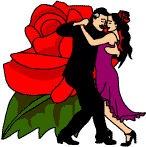Tango to San Telmo
Created | Updated Jan 28, 2002

The haunting melody of the Tango brings to mind exotic passions, romance, handsome Latin men and earthy, voluptuous women; so it is not surprising that this raunchy dance is linked with the seedier elements of Argentine society.
The Tango emerged in the 1880s from the immigrant ghettos of Buenos Aires with their complex mix of European cultures. These were dangerous areas of ill-repute and the rough, violent dance that arose in its bars and bordellos reflected the flick of a knife, the arrogant machismo strut and the suggestion of sex that permeated its every move. By the 1900s the dance had been formalised by the general population and a slightly more sanitised version gained in popularity throughout the whole of Buenos Aires.
The Tango became known in Europe after the First World War when a group of Argentine intellectuals made their annual trip to Paris and thought they would have fun teaching this 'disreputable' dance to their friends. To their surprise the dance took Paris by storm and soon elevated it to high society.
The Tango's sudden world popularity came from an unusual source. A British dancer, Vernon Blyth, and his wife, Irene (they later changed their name to Castle) had been trying to make a name for themselves in the United States, but without much success. They returned to Europe where they managed to find work at the Café de Paris. It was here that they first saw the dance that was to propel them to stardom.
They learned the dance, removed the more suggestive moves, and returned to the USA with their new act. They were an immediate hit and opened up Castle Tango Palaces and 'Tea Dance' ballrooms all over America as the Tango, and its accompanying cocktails, caught the imagination of people everywhere. Although it was said that Queen Mary refused to attend any parties if the Tango was to be danced, for everyone else it became the rage.
To begin with the Tango was just a dance, it was only later that words were added. Carlos Gardel was the first popular Tango singer, introducing lyrics that were as earthy as the dance, using the same street slang as that used by the original dancers. Although he died in suspicious circumstances in 1935, Carlos Gardel is still revered today as the greatest Tango singer ever and snatches of his recordings can still be heard as you wander through the streets of Buenos Aires. The memory of this charismatic performer is so strong in the Argentine mind that, on hearing him sing, people will say, 'Gardel sings better every day,' thus keeping his spirit and his music alive.
Today, the best place to experience the Tango is still at its place of birth, Buenos Aires, where the Mecca for aficionados is San Telmo. This area has been protected as an historical zone and all the pre-20th Century buildings have been preserved. Just walking through the streets gives a feeling of having strayed into a time warp as many of its inhabitants still affect the style of clothing that would not have looked out of place in the 1930s or 1940s. This district epitomises the El Sur or the south, which was sung about so passionately by Tango singers such as Astor Piazzola and Nestor Marconi. Tango clubs and piano bars that come alive at night and where style and atmosphere are paramount populate its streets. This is where authentic Tango can be experienced, far removed from the tourist shows with their rehearsed dramatisation.
On Sundays, the Plaza Dorrego in San Telmo hosts an antiques fair where one can see the Tango danced in the streets, while elderly Tango singers pour out their hearts on every corner; still seemingly dressed in the same silk scarves and slouch hats that they wore 60 years before. The nostalgic atmosphere permeates the square, even extending to the bars with their rough wooden tables and peanut shell strewn floors.
If you ever get a chance to wander around San Telmo and soak up the evocative atmosphere, remember to look for authentic clothing of a bygone era, so that when you are finally seduced into dancing the Tango, you will at least look the part.

